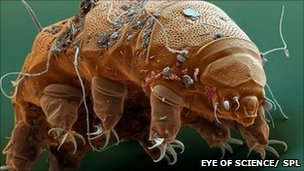They may look like a bad creature costume from a Sci Fi Thriller from the 1950’s, but these little guys may well hold the key to our exploration of deep space in their tiny, tiny…tiny little…um, claws? Fingers? Cillia? Oh, I give up.

Tardigrades are microscopic animals commonly known as water bears or moss piglets
Okay, we are not breeding them as some sort of watchdog like Woola from the recent John Carter movie (did anyone but me see that?) At largest Tardigrades are a whopping 1/20th of an inch long. But there is seemingly nothing that can kill them. Cockroaches bend the knee to these guys when it comes to surviving hardship. When Wall-E’s little cockroach is dead and the world is truly a barren and desolate place, these things will still be around and who knows, they could be the seed of a whole new process of evolution.
One way in which Tardigrades have adapted to various types of environments, has been to reversibly suspend their metabolism. This state is known as cryptobiosis and is a truly deathlike state. Metabolism lowers to 0.01% of normal or is entirely undetectable and the water content of the body decreases to less than 1%.
Anhydrobiosis is an almost complete loss of body water and the animal can stay in this state for an extended period of time. Tun formation, a vital part of the process, results in a body that is constricted and folded. Wax extrusion covers the surface and may help to reduce transpiration (water loss by evaporation). The tun formation process requires active metabolism. The relative humidity required for tun formation to be successful varies between 70-95%, depending on the species. Once the tun is formed further desiccation can take place in 0% relative humidity and the Tardigrade can still survive.
Cryobiosis is a form of cryptobiosis which is initiated by a reduction in temperature and involves the ordered freezing of water within the cells. Recent studies done by Somme in 1995 and 1996 have helped to develop a greater understanding of the mechanism Tardigrades use to survive extreme temperatures. Cryobiosis allows Tardigrades to tolerate rapid freezing and thawing cycles and allows for tardigrades in Arctic and Antarctic habits to withstand the temperature changes which occur.
Osmobiosis is a form of cryptobiosis initiated by a decreased water potential due to increased solute concentration in the surrounding solution.Upon immersion in non-ambient saline solutions tardigrades commonly contract rapidly into a tun. However, this is not necessary since active animals can survive high salinity.
While in a state of cryptobiosis organisms are able to resist environmental extremes that would be instantly lethal to the animal if in the active state.
In the 1920’s P. G. Rahm of the University of Freidburg discovered tardigrades were able to withstand being heated for a few minutes in 151 degrees Celsius and survive being chilled for days in temperatures up to minus 200 degrees Celsius. While in this state the organisms are also greatly resistant to ionizing radiation as shown by Raul M. May from the University of Paris who found that 570,00 roentgens were required to kill 50% of exposed tardigrades (only 500 roentgens would be fatal to a human). Water bears are also resistant to vacuums. Specimens exposed to high vacuum and electron bombardment in a SEM for 0.5 hours were then revived and survived for a few minutes before dying.
To get all that in more scientific language, you can check out Fun Tardigrade Facts at Sun.IWU.EDU.
According to BBC.com.UK we are launching Tardigrades into space for study as part of an Italian Space Agency study on the effects of radiation on cellular biology.
Project Biokis is sponsored by the Italian Space Agency and will investigate the impact of short-duration spaceflight on a number of microscopic organisms.
The project will use seven experiments to investigate how spaceflight affects organisms on a molecular level.
The team will be using molecular biology to evaluate any changes in the organisms’ genetic information, as well as investigating how cells physically adapt to cope with extreme dehydration, caused by the space vacuum, and damage caused by cosmic radiation.
One of these experiments, the Tardkiss experiment, will expose colonies of tardigrade to different levels of ionising radiation, determined using an instrument called a dosimeter, at different points during the spaceflight mission.
The results from Tardkiss will enable researchers to determine how radiation dosage effects the way cells work.
I just hope they don’t mutate and start growing to Godzilla like size to take over the Earth. But if it happens, you heard it here first.
Keep watching the ponds!
6 comments




